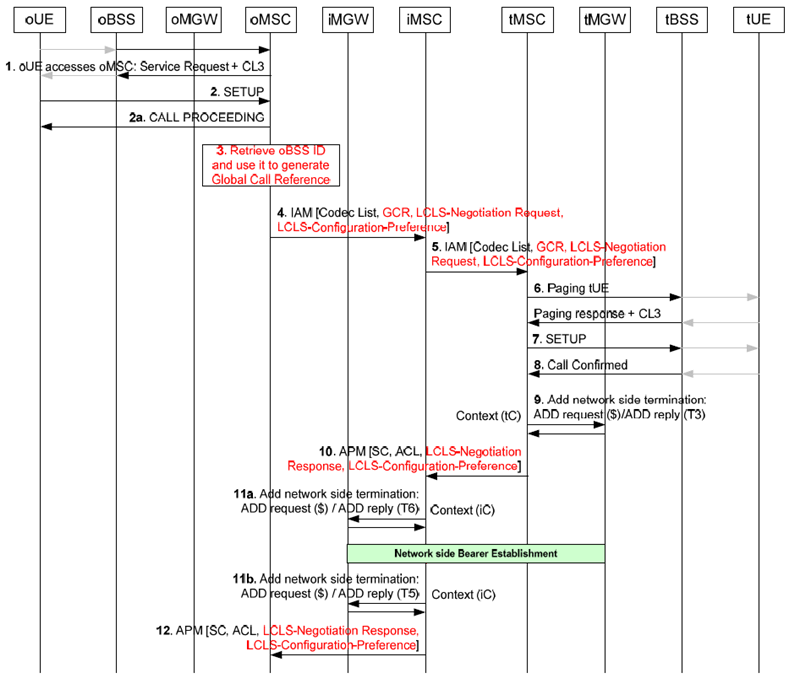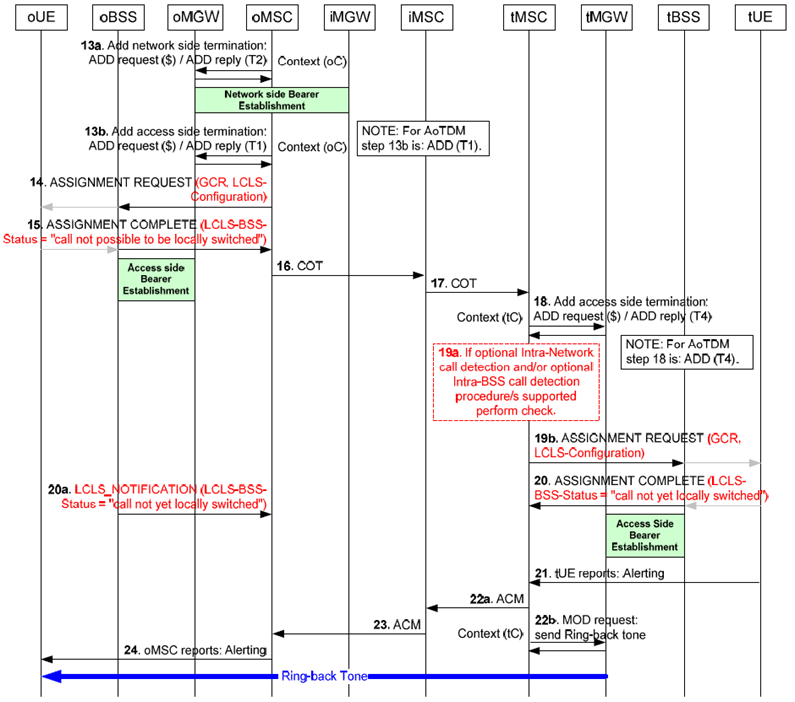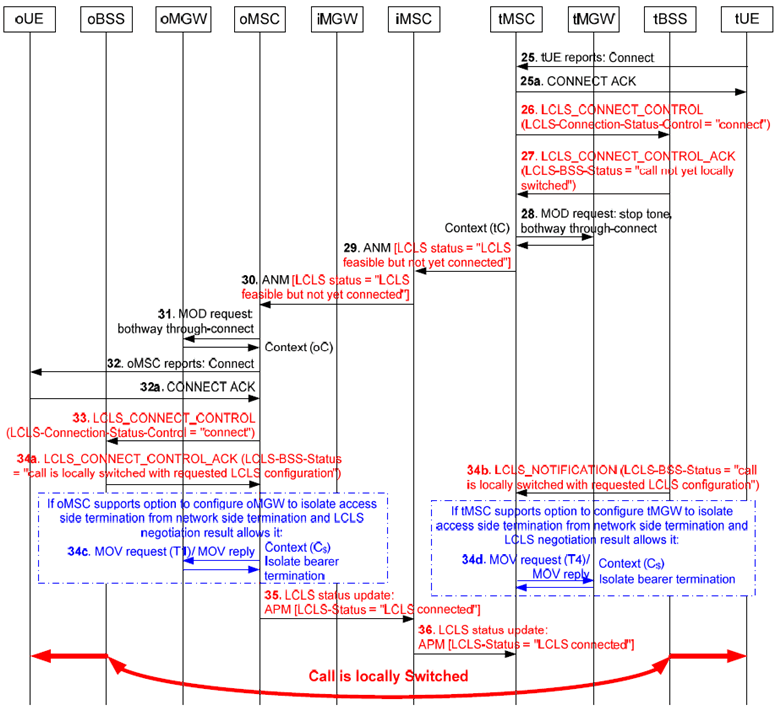Content for TS 23.284 Word version: 18.0.0
1…
4…
4.2…
4.3…
5
6…
6.3…
6.3.2
6.3.3
6.3.4
6.3.5
7…
7.2.4…
7.2.4.2
7.2.4.3
7.2.4.4
7.2.4.5
7.2.4.6
7.3…
7.3.4…
7.3.4.2
7.3.4.3
7.3.4.4
8…
8.2.3
8.3…
8.3.2
8.4…
8.4.1.1.7…
8.4.1.2…
8.4.2…
8.4.2.2…
8.4.5…
8.4.5.6
8.4.5.7
8.4.5.8…
9…
13…
13.4…
13.4.3…
13.4.4…
13.5…
13.6…
13.7…
14…
16…
A…
A.2…
6.3.2 LCLS established, Basic Call Example with BICC based CS core network, forward bearer establishment p. 30
Figure 6.3.2.1, Figure 6.3.2.2 and Figure 6.3.2.3 show the message sequence example for the basic call establishment for LCLS. In this example the oUE and the tUE belong to the same BSS (marked as oBSS and tBSS) and the CN permits LCLS. The example is based on examples from TS 23.205 for the basic mobile originating call, forward bearer establishment (case when access bearer assignment is requested on the originating side after reception of Bearer Information message) and the basic mobile terminating call, forward bearer establishment.

Figure 6.3.2.1: Basic Call Establishment Flow when call is locally switched, forward bearer establishment
(⇒ copy of original 3GPP image)
(⇒ copy of original 3GPP image)
Step 1.
Service Request handling.
Step 2.
Originating Call SETUP.
Step 2a.
The oMSC server replies with the CALL PROCEEDING message to indicate that the call is being processed.
Step 3.
If the oMSC server supports LCLS it retrieves the oBSS ID and generates the Global Call Reference for the call.
Step 4.
The oMSC server sends the IAM message including supported codecs list, GCR with encapsulated oBSS ID, the LCLS-Negotiation Request IE and the LCLS-Configuration-Preference IE.
Step 5.
If the iMSC server supports LCLS it may modify the LCLS-Negotiation Request IE and the LCLS-Configuration-Preference IE due to CAMEL, supplementary service requirements etc. before sending the IAM message containing the GCR with the encapsulated oBSS ID, the LCLS-Negotiation Request IE and the LCLS-Configuration-Preference IE.
Step 6.
The tMSC server pages the tUE.
Step 7.
The tMSC server performs call Setup.
Step 8.
The tUE confirms the call.
Step 9.
The tMSC server requests the tMGW to prepare for the network side bearer establishment.
Step 10.
After the tMGW has replied with the bearer address and the binding reference the tMSC server returns the APM message with the selected codec, available codec list and if LCLS is supported, the LCLS-Negotiation Response IE and the LCLS-Configuration-Preference IE.
Step 11a.
When the bearer information is received the iMSC server requests the seizure of the outgoing network side bearer termination.
Step 11b.
After the outgoing side bearer termination is seized the iMSC server requests the seizure of the incoming network side bearer termination.
During the seizure of the outgoing side and the incoming side bearer termination the iMSC server will also request the iMGW to through-connect the bearer terminations so that the bearer will be both way through-connected.
Step 12.
The iMSC server transfers the APM message with the selected codec, available codec list, the LCLS-Negotiation Response IE and the LCLS-Configuration-Preference IE.

Figure 6.3.2.2: Basic Call Establishment when call is locally switched, forward bearer establishment (continuation of Figure 6.3.2.1)
(⇒ copy of original 3GPP image)
(⇒ copy of original 3GPP image)
Step 13a.
When the bearer information is received the oMSC server requests the seizure of the network side bearer termination.
Step 13b.
After the network side bearer information is seized the oMSC server requests the seizure of the access side bearer termination.
During the seizure of the network side or the access side bearer termination the oMSC server will also request the oMGW to through-connect the bearer terminations so that the bearer will be backward through-connected.
Step 14.
The oMSC server determines whether LCLS is allowed in the core network based on the returned LCLS-Negotiation IE and if so the oMSC server includes the LCLS-Configuration IE in the ASSIGNMENT REQUEST message along with the GCR IE.
Step 15.
The oBSS returns the ASSIGNMENT COMPLETE message with the LCLS-BSS-Status IE indicating "call not possible to be locally switched".
Step 16.
When the access assignment is completed the oMSC server sends the Continuity (COT) message to the iMSC server.
Step 17.
The iMSC server transfers the COT message to the tMSC server.
Step 18.
The tMSC server requests the seizure of the access side bearer termination. If not requested during the seizure of network side bearer termination (in step 9) the tMSC server will also request the tMGW to through-connect the bearer terminations so that the bearer will be backward through-connected.
Step 19a.
If the tMSC server supports the optional "intra-Network call detection" procedure it compares its own Network ID with the Network ID received within the Global Call Reference IE.
If the tMSC server supports the optional "intra-BSS call detection" procedure it compares the BSS ID of the selected terminating BSS with the oBSS ID received within the Global Call Reference IE at this step. Since the oUE and the tUE belong to the same BSS the call continues the same way as for the basic LCLS establishment without this pre-check.
Step 19b.
The tMSC server performs the access bearer assignment and sends the ASSIGNMENT REQUEST message containing the GCR IE and the LCLS-Configuration IE if LCLS is permitted in the core network.
Step 20.
The oBSS/tBSS performs the GCR correlation. Since the GCR correlation has identified the call as an intra BSS call and LCLS is allowed in the BSS, the tBSS returns the ASSIGMENT COMPLETE message with the LCLS-BSS-Status IE indicating "Call not yet locally switched".
Step 20a.
Since the GCR correlation has identified the call as an intra BSS call and LCLS is allowed in the BSS, the oBSS signals the LCLS status change by sending the LCLS_NOTIFICATION message with the LCLS-BSS-Status IE set to "Call not yet locally switched".
Step 21.
The tUE reports alerting.
Step 22a, b.
The tMSC server returns the ACM message and requests the tMGW to provide a ring-back tone.
Step 23.
The iMSC server transfers the ACM message to the oMSC server.
Step 24.
The oMSC server reports alerting.

Figure 6.3.2.3: Basic Call Establishment when call is locally switched, forward bearer establishment (continuation of Figure 6.3.2.2)
(⇒ copy of original 3GPP image)
(⇒ copy of original 3GPP image)
Step 25.
The tUE answers the call.
Step 25a.
The tMSC server returns the CONNECT ACKNOWLEDGE message to the tUE.
Step 26.
The tMSC server indicates to the tBSS that this call leg is ready to be locally switched by sending the LCLS_CONNECT_CONTROL message (note the BSS cannot through-connect LCLS until it receives the same indication from the oMSC server).
Step 27.
The tBSS returns the LCLS_CONNECT_CONTROL_ACK message with the LCLS-BSS-Status IE set to "Call not yet locally switched" since the BSS has not received the same order from the oMSC server.
Step 28.
When the tMSC server receives the Connect message it requests the tMGW to stop providing ring-back tone to the calling party and requests to bothway through-connect the bearer.
Step 29.
The tMSC server returns the ANM message with the LCLS-Status IE indicating "LCLS is feasible but not yet connected".
Step 30.
The oMSC server receives the ANM message with the LCLS-Status IE indicating "LCLS is feasible but not yet connected".
Step 31.
The oMSC server request the oMGW to bothway through-connect the bearer.
Step 32.
The oMSC server reports Answer/Connect to the oUE.
Step 32a.
The oUE completes the call establishment with the CONNECT ACKNOWLEDGE message.
Step 33.
The oMSC server requests the oBSS to connect LCLS since the received ANM message indicated "LCLS is feasible but not yet connected".
Step 34a.
Since the BSS has received the through connect request for both call legs the oBSS returns the LCLS_CONNECT_CONTROL_ACK message with the LCLS-BSS-Status IE set to "call is locally switched with requested LCLS configuration".
Step 34b.
Since the BSS has received the through connect request for both call legs the tBSS signals the LCLS status change by sending the LCLS_NOTIFICATION message with the LCLS-BSS-Status IE set to "call is locally switched with requested LCLS configuration".
Step 34c.
If the oMSC server supports the option to configure its Access MGW to isolate the access side termination from the network side termination and LCLS negotiation indicated that no succeeding node requires the UL data from the oUE then the oMSC server requests the oMGW to isolate the access side termination T1 from the network side termination T2.
Step 34d.
If the tMSC server supports the option to configure its Access MGW to isolate the access side termination from the network side termination and LCLS negotiation indicated that no preceding node requires the UL data from the tUE then the tMSC server requests the tMGW to isolate the access side termination T4 from the network side termination T3.
Step 35.
The oMSC server signals the change of the LCLS status through the Core Network by sending the APM message with the LCLS-Status IE set to "LCLS connected".
Step 36.
The iMSC server transfers the change of the LCLS status to the tMSC server.